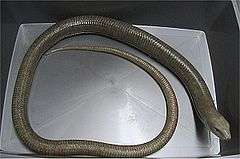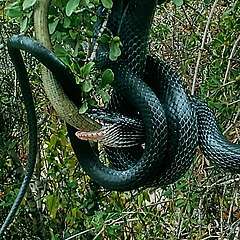Sheltopusik
The sheltopusik[2] /ˌʃɛltəˈpjuːzɪk/ (Pseudopus apodus), also commonly called Pallas's glass lizard[3] or the European legless lizard, is a species of large glass lizard found from Southern Europe to Central Asia.
| Sheltopusik | |
|---|---|
.jpg) | |
| Scientific classification | |
| Kingdom: | Animalia |
| Phylum: | Chordata |
| Class: | Reptilia |
| Order: | Squamata |
| Family: | Anguidae |
| Genus: | Pseudopus |
| Species: | P. apodus |
| Binomial name | |
| Pseudopus apodus (Pallas, 1775) | |
| Synonyms[1] | |
Etymology
The common name "sheltopusik" comes from Russian желтопузик (zheltopuzik), literally "yellow-bellied".[4]
Taxonomy
The sheltopusik was previously included in the genus Ophisaurus, but has been placed in its own genus Pseudopus. It was originally described in 1775 by Peter Simon Pallas as Lacerta apoda.[5]
Description
The sheltopusik can reach a length of 135 cm (4.43 ft). It is tan colored, paler on the ventral surface and the head, with a ring-like/segmented appearance that makes it look like a giant earthworm with a distinctive fold of skin down each side called a lateral groove. Small (2-mm) rear legs are sometimes visible near the cloaca. Though the legs are barely discernible, the sheltopusik can be quickly distinguished from a snake by its ears, eyelids, and ventral scales.
Habitat and behaviour
P. apodus inhabits open country, such as short grassland or sparsely wooded hills. It consumes arthropods and small mammals. Snails and slugs appear to be its favorite prey, which may explain why it is particularly active in wet weather, although it prefers a dry habitat.
Defensive behaviour
Due to its size, the sheltopusik tends to respond to harassment by hissing, biting, and musking. It is less likely to drop off its tail than some other species that display caudal autotomy. However, these occasional displays of caudal autotomy are responsible for the name "glass lizard" (or "glass snake"). The released tail may break into pieces, leading to the myth that the lizard can shatter like glass and reassemble itself later. In reality, if the tail is lost, it grows back slowly, but is shorter and darker; it may grow back to full length as it grows.


In captivity
Sheltopusiks are frequently available in the exotic pet trade, though rarely captive-bred. They do not typically tolerate a large amount of handling, but they adapt to captivity well, feeding on crickets, meal worms, small mice, eggs, snails, or pieces of meat which they even accept from a keeper's tweezers, or even from the hands once they become used to captivity. However, they do get excited around food and have surprisingly powerful jaws. They make hardy captives, capable of living up to 50 years.
Reproduction
About 10 weeks after mating, the female P. apodus lays about eight eggs, which she hides under bark or a stone, and often guards them. The young hatch after 45 to 55 days. They are typically about 15 cm (5.9 in) long and usually start to eat after four days.
See also
References
- "Pseudopus apodus ". The Reptile Database. www.reptile-database.org.
- Also spelled scheltopusik, sheltopusick, scheltopusick, sheltopusic, or scheltopusic.
- Beolens, Bo; Watkins, Michael; Grayson, Michael (2011). The Eponym Dictionary of Reptiles. Baltimore: Johns Hopkins University Press. xiii + 296 pp. ISBN 978-1-4214-0135-5. (Pseudopus apodus, p. 199).
- Н. Б. Ананьева (2004). Атлас пресмыкающихся Северной Евразии: таксономическое разнообразие, географическое распространение и природоохранный статус. Зоол. инст. РАН. ISBN 978-5-98092-007-4.
- Lacerta apoda. Peter Simon Pallas. Published: 1775.
External links
- "The Scheltopusik, Pseudopus [Ophisaurus ] apodus: Natural History and Care". Cyber Lizard U.K. 2003-09-28. Retrieved 2008-01-19.
- "Scheltopusik Care Sheet and Information". Western New York Herpetological Society. 2008. Retrieved 2008-01-19.
- Kaplan, Melissa (1997). "Glass Lizard - Glass Snake - Legless Lizard". Melissa Kaplan's Herp Care Collection. Retrieved 2008-01-19.
- "European Glass Lizard". Wild Natures. September 2006. Archived from the original on 2008-04-02. Retrieved 2008-01-19.
- "Giant Legless Lizard". Central Pets. 2008-01-19. Archived from the original on 2007-10-16. Retrieved 2008-01-19.
Further reading
- Arnold EN, Burton JA (1978). A Field Guide to the Reptiles and Amphibians of Britain and Europe. London: Collins. 272 pp. + Plates 1-40. (Ophisaurus apodus, pp. 175, 178 + Plate 33, figures 1a-1b + Map 94).
- Boulenger GA (1885). Catalogue of the Lizards in the British Museum Natural History). Second Edition. Volume II. ... Anguidæ ... London: Trustees of the British Museum (Natural History). (Taylor and Francis, printers). xiii + 497 pp. + Plates I-XXIV. (Ophisaurus apus, new combination, pp. 280–281).
- Pallas PS (1775). "Lacerta apoda, descripta ". Novi Comentarii Academiae Scientiarum Imperialis Petropolitanae 19: 435-454 + Plates IX-X. (Lacerta apoda, new species). (in Latin).
| Wikimedia Commons has media related to Pseudopus apodus. |
| Wikispecies has information related to Sheltopusik |